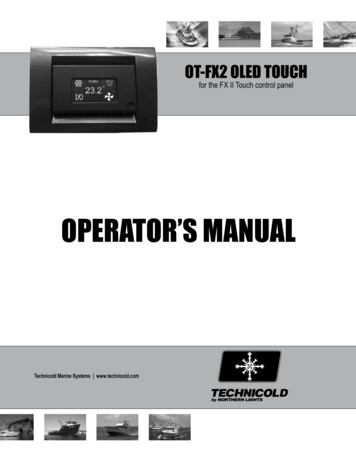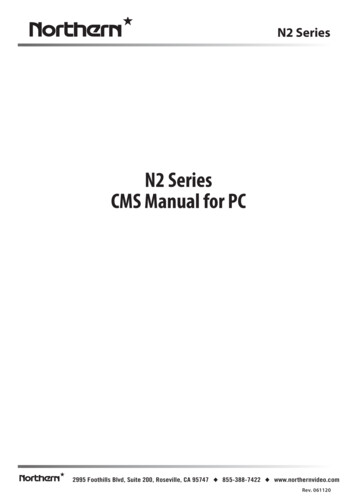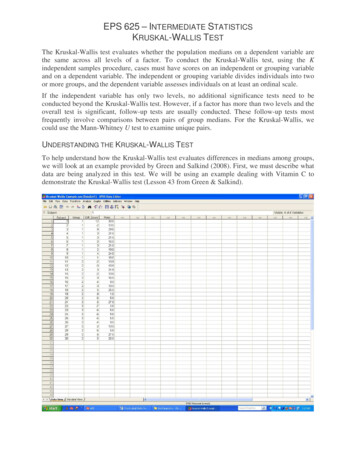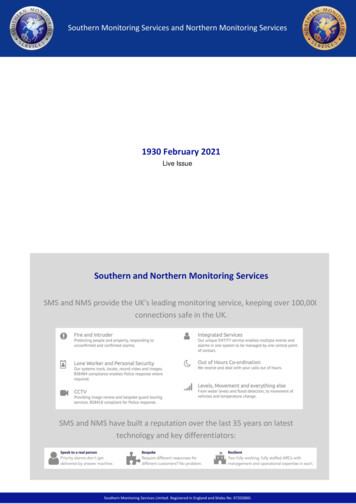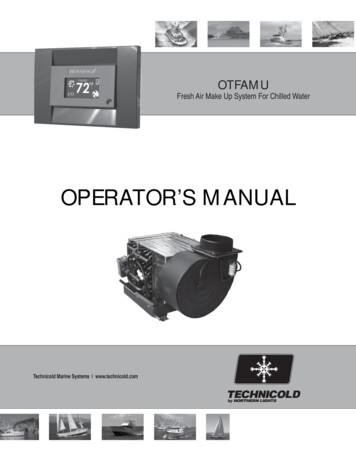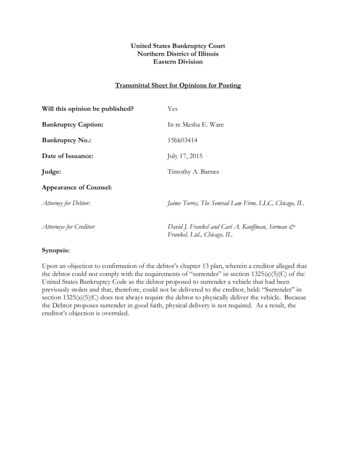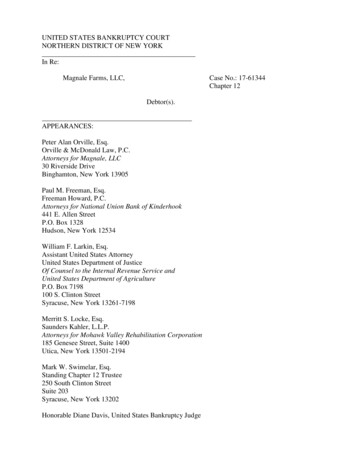
Transcription
InstructionManualOperation / Safety / MaintenanceMeets applicable requirements ofASME/ANSI B30.1 2004AU/NZS 2693:2007Read this instructionmanual before using the Hi-Lift Jack.The instructionmanual is alsoavailable in Spanishand French at nocharge upon request.
ContentsHi-Lift Jack Components.1Safety.3Safety Symbols.3Safety Warnings.4Handle Safety Decal.6General Safety.8Operation Instructions.9Raising a Stationary Load.9Lowering a Stationary Load.12Clamping or Winching. 14Maintenance Instructions. 16Clean . 16Binding. 16Storing the Jack. 16Storing the Equipment-Agricultural Jack. 17Inspection . 17Lubrication . 17Repair.18Parts. 20Specifications. 22Limited Warranty. 26
Hi-Lift Jack CompanyP.O. Box 228Bloomfield, IN 47424-0228 USAToll Free: 800.233.2051Direct: 812.384.4441Fax: 812.384.4592Web: http://www.hi-lift.comTo the Owner / UserThank you for purchasing this Hi-Lift Jack. Withproper use and care, your jack will give you years ofdependable service. You can use the Hi-Lift Jack inmany ways, including: Lifting stable loads. Winching loads. Clamping Spreading. Raising vehicles or other mobile loads (whenproperly chocked, blocked and stabilized).Store these instructions in the handle of your jack.Use only genuine Hi-Lift replacement parts. Usingreplacement parts not supplied by Hi-Lift JackCompany will make the jack unsafe for use and voidthe warranty.
Hi-Lift Jack ComponentsGet to know the components of your jack before youbegin use.Top clamp-clevisTop clamp-clevisbolt & nutSteel standard barSteel standardbar holesHandlePitmanSmall runnerCotter pinLarge runnerBase plate1
Components · Running GearThe following shows the parts associated with therunning gear:Handle clipspringHandle socketPitman pinReversing switchcam barHex bolt & nutReversing latchCross pinClimbing pinspringShear bolt & nutClimbing pinCross pinClimbing pin springClimbing pinCap screw with washer2
Safety - WarningsSafetyAll users must read and understand theinstructions and safety warnings in thismanual and the safety labels placed onthe product before using the jack. Eachuser must use the jack safely and maintainit properly.If any users are not fluent in English,have someone read the instructions tothem. Manuals are also available in otherlanguages upon request at no charge.If you have any questions about using thejack safely or if you need a new label ormanual, see the contact information onthe opposite page.Safety Symbols!DANGERThe DANGER! safety symbol indicates a hazard orunsafe practice that will result in serious injury or death.! WARNINGThe WARNING! safety symbol indicates a hazard orunsafe practice that could result in serious injury ordeath.3
Safety Warnings!DANGERDO NOT USE THE JACK TO SUPPORTOR STABILIZE A LOAD. Using the jackto support or stabilize a load may resultin unexpected movement and result inserious injury, being crushed and death.Always securely chock and block (stabilize)the load to be lifted. Never place any partof the body under a raised load withoutproperly chocking and supporting the load.Using the jack on curved or tubular vehiclebumpers will result in the vehicle slippingoff the jack and falling, causing seriousinjury or death. Use the Bumper Lift orLift-Mate to lift most vehicles with curvedbumpers or plastic bumpers.When using the jack as a winch:Always use chains or tow straps that havea greater working load than the jack. If achain or tow strap breaks while winching,the load could shift or the chain or towstrap could snap back.When used as a winch, the top clampclevis will support up to 5,000 lbs. (2273kg). Going over this limit will result in thetop clamp-clevis bending or breaking,causing the load to move or the chain ortow strap to snap back. This will result inserious injury or death.When using the jack for clamping, themaximum clamping force of the standardtop clamp-clevis is 750 lbs. (340 kg). Ifyou exceed this limit, the standard topclamp-clevis could bend or break, resultingin serious injury or death.Unexpected movement of the jack handlemay result in the user being struck causingserious injury or death. Always keep yourhead away from and out of the jack handlepath of movement.4
Safety - WarningsThe jack handle may move rapidly whenmoving the reversing latch and causeserious injury or death. Always place thehandle against the steel standard barwith the handle clip spring holding it upbefore moving the reversing latch. Thiswill prevent the handle from moving upand down rapidly. Securely hold on to thejack handle so your hands do not slip andensure the handle is not in the horizontalposition when moving the reversing latch.Important! During lifting and lowering, theweight of the load pushes up against thejack’s handle. If your hands slip off thehandle, or if the handle is horizontal whenyou move the reversing latch, it may moveup very quickly.Raising an inflated tire more than 2” (5cm) above the ground or attempting to liftmore than one wheel at a time may resultin tip over, unexpected movement andserious injury or death. Always raise aninflated tire less than 2” (5 cm) and onlyone tire at a time.! WARNINGThe jack, while standing vertical andunsupported, may tip over and causeserious injury or death. Always supportthe jack or lay it on it’s side when not inuse.This jack will not operate safely withoutproper lubrication. Using the jack withoutproper lubrication will result in poorperformance and damage to the jack.The jack is not self-lubricating, inspectthe jack before use and lubricate whennecessary.5
Handle Safety DecalImportant! Replace handle safety decal if damagedor removed.The following hazards or unsafe practiceswill cause serious injury or deathDO NOT USE THE JACK TO SUPPORT OR STABILIZEA LOAD. Using the jack to support or stabilize aload may result in unexpected movement andresult in serious injury, being crushed and death.Always securely chock and block (stabilize) theload to be lifted. Never place any part of the bodyunder a raised load without properly chockingand supporting the load.Using the jack on curved or tubular vehiclebumpers will result in the vehicle slipping off thejack and falling, causing serious injury or death.Use the Bumper Lift or Lift-Mate to lift mostvehicles with curved bumpers or plastic bumpers.When using the jack as a winch:Always use chains or tow straps that have agreater working load than the jack. If a chain ortow strap breaks while winching, the load couldshift or the chain or tow strap could snap back.When used as a winch, the top clamp-clevis willsupport up to 5,000 lbs. (2273 kg). Going over thislimit will result in the top clamp-clevis bending orbreaking, causing the load to move or the chainor tow strap to snap back. This will result inserious injury or death.When using the jack for clamping, the maximumclamping force of the standard top clamp-clevis is750 lbs. (340 kg). If you exceed this limit, thestandard top clamp-clevis could bend or break,resulting in serious injury or death.Unexpected movement of the jack handle mayresult in the user being struck causing seriousinjury or death. Always keep your head away fromand out of the jack handle path of movement.The jack handle may move rapidly when movingthe reversing latch and cause serious injury ordeath. Always place the handle against the steelstandard bar with the handle clip spring holdingit up before moving the reversing latch. This willprevent the handle from moving up and downrapidly. Securely hold on to the jack handle soyour hands do not slip and ensure the handle isnot in the horizontal position when moving thereversing latch.Important! During lifting and lowering, theweight of the load pushes up against the jack’shandle. If your hands slip off the handle, or if thehandle is horizontal when you move the reversinglatch, it may move up very quickly.Raising an inflated tire more than 2” (5cm) abovethe ground or attempting to lift more than onewheel at a time may result in tip over, unexpectedmovement and serious injury or death. Alwaysraise an inflated tire less than 2” (5cm) and onlyone tire at a time.Handle force required to raise 4,660 lbs. is 177lbs. at 34” on the handle. Maximum rated load is4,660 lbs. (2273 kg) up to 48”6 (121 cm), tested to7,000 lbs. (3175 kg). Upper 12” of 60” jack is
prevent the handle from moving up and downrapidly. Securely hold on to the jack handle soyour hands do not slip and ensure the handle Safetyis- Warningsnot in the horizontal position when moving thereversing latch.Important! During lifting and lowering, theweight of the load pushes up against the jack’shandle. If your hands slip off the handle, or if thehandle is horizontal when you move the reversinglatch, it may move up very quickly.Raising an inflated tire more than 2” (5cm) abovethe ground or attempting to lift more than onewheel at a time may result in tip over, unexpectedmovement and serious injury or death. Alwaysraise an inflated tire less than 2” (5cm) and onlyone tire at a time.Handle force required to raise 4,660 lbs. is 177lbs. at 34” on the handle. Maximum rated load is4,660 lbs. (2273 kg) up to 48” (121 cm), tested to7,000 lbs. (3175 kg). Upper 12” of 60” jack israted to 2,660 lbs. (1209 kg) only, tested to 4,000lbs. (1818 kg). If you overload the jack duringoperation, the shear bolt will break. If the shearbolt breaks, as it will at 7,000 lbs. (3175 kg), theload should be supported, but the jack’s handlewill drop freely. Use a jack with a larger loadcapacity to lower the load safely to the ground.Do not replace the shear bolt with a bolt ofgreater strength as this could cause the jack tofail and drop the load. Always use a shear boltsupplied by Hi-Lift Jack Company. Do notreplace the shear bolt while the jack is underload.The following hazards or unsafe practicesmay cause serious injury or deathThe jack, while standing vertical andunsupported, may tip over and cause seriousinjury or death. Always support the jack or lay iton it’s side when not in use.This jack will not operate safely without properlubrication. Using the jack without properlubrication will result in poor performance anddamage to the jack. The jack is notself-lubricating, inspect the jack before use andlubricate when necessary.All users must read and understand theinstructions and safety warnings in theinstruction manual and on this product beforeusing the jack. Each user must use the jacksafely and maintain it properly.If any users are not fluent in English, havesomeone read the instructions to them.Manuals are also available in other languagesupon request at no charge.If you have any questions about using the jacksafely, need a new label or manual contact:Hi-Jack CompanyP.O. Box 228Bloomfield, IN 47424-0228 USAToll Free: 800.233.2051Direct: 812.384.4441Fax: 812.384.4592Web: http://www.hi-lift.com7
Safety - GeneralGeneral SafetyTraining Read this manual before use. Do not allow anyonewho has not read this manual, and/or does notunderstand the requirements, use the jack.Spectators Do not allow bystanders around the jack or underthe load supported only by the jack.Inspection Inspect the jack carefully before each use. Ensurethe jack is not damaged, excessively worn, ormissing parts. Check the climbing pins to make sure that they arenot worn or damaged. Check the steel standard bar to make sure that itis straight and that nothing is blocking the steelstandard bar holes. Do not use the jack unless it is in good cleanworking condition. Do not use the jack unless it is properly lubricated. Using a jack that is not in good clean workingcondition or properly lubricated may cause seriousinjury (see Lubrication).Chock and Block (Stabilize)A chock is a wedge for steadying an object and holdingit motionless, or for preventing the movement of awheel. Chock the wheel opposite the end being lifted.When you block a load, you secure and support a loadthat is being lifted. The block(s) or stabilizer(s) shouldhave a weight capacity that is greater than the weightof the load which is being lifted. Do not use the jack tosupport the load.Blocks stabilize the loadChocks prevent movement8
Operation InstructionsRaising a Stationary Load!DANGERDO NOT USE THE JACK TO SUPPORTOR STABILIZE A LOAD. Using the jackto support or stabilize a load may resultin unexpected movement and result inserious injury, being crushed and death.Always securely chock and block (stabilize)the load to be lifted. Never place any partof the body under a raised load withoutproperly chocking and supporting the load.Using the jack on curved or tubular vehiclebumpers will result in the vehicle slippingoff the jack and falling, causing seriousinjury or death. Use the Bumper Lift orLift-Mate to lift most vehicles with curvedbumpers or plastic bumpers.Unexpected movement of the jack handlemay result in the user being struck causingserious injury or death. Always keep yourhead away from and out of the jack handlepath of movement.The jack handle may move rapidly whenmoving the reversing latch and causeserious injury or death. Always place thehandle against the steel standard barwith the handle clip spring holding it upbefore moving the reversing latch. Thiswill prevent the handle from moving upand down rapidly. Securely hold on to thejack handle so your hands do not slip andensure the handle is not in the horizontalposition when moving the reversing latch.Important! During lifting and lowering, theweight of the load pushes up against thejack’s handle. If your hands slip off thehandle, or if the handle is horizontal whenyou move the reversing latch, it may moveup very quickly.9
Operation · Raising a Stationary LoadRaising an inflated tire more than 2” (5cm) above the ground or attempting to liftmore than one wheel at a time may resultin tip over, unexpected movement andserious injury or death. Always raise aninflated tire less than 2” (5 cm) and onlyone tire at a time.Handle force required to raise 4,660 lbs. is177 lbs. at 34” on the handle. Maximumrated load is 4,660 lbs. (2273 kg) up to48” (121 cm), tested to 7,000 lbs. (3175kg). Upper 12” of 60” jack is rated to2,660 lbs. (1209 kg) only, tested to 4,000lbs. (1818 kg).If you overload the jack during operation,the shear bolt will break. If the shear boltbreaks, as it will at 7,000 lbs. (3175 kg),the load should be supported, but thejack’s handle will drop freely. Use a jackwith a larger load capacity to lower theload safely to the ground. Do not replacethe shear bolt with a bolt of greaterstrength as this could cause the jack tofail and drop the load. Always use a shearbolt supplied by Hi-Lift Jack Company. Donot replace the shear bolt while the jack isunder load.1. Securely chock and stabilize the load to preventit from rolling or shifting as you lift it (see GeneralSafety: Chock and Block).12. Place the jack’s base plate securely on a firm, level,and dry surface with the steel standard bar pointingstraight up.3. Lift the reversing latch until it locks in the upposition.4. Pull the handle away from the steel standard bar,releasing the handle clip spring.5. Grasp the handle or the handle socket and raise thelifting mechanism until the large runner is completelyand securely under the load.10
Operation · Raising a Stationary Load64352Important!Keep the handle against steel standard bar with thehandle clip spring holding it when not lifting or lowering.7986. Grasp the handle firmly with both hands. Carefullypump the handle up and down to raise the load. Donot use an extension on the handle.The load will be raised on each down stroke of thehandle. Watch the load and the jack carefully. Stoplifting if either one starts to move. Do not continueuntil it is safe to do so. When safe, stabilize andblock the load.7. When the load is raised to the desired height, placethe handle in the upright position clipped to the steelstandard bar.8. Block the load securely.9. Lower the load onto the blocks (see Lowering aStationary Load).10. Remove the jack from the stabilized load.11
Additional Instructions For Equipment-Agricultural Jack1. When attaching the Equipment-Agricultural jack toequipment using tubular mounting brackets, alwaysplace lock-pin completely through the holes in thetubular mounting bracket.2. Always secure the lock-pin in the tubular bracketswith the safety cotter pin.3. Chock the equipment that you have attached theEquipment-Agricultural jack to before lifting with theEquipment-Agricultural jack. Side lift is limited to2,000 lbs. (907 kg).After you have properly hooked the raisedequipment to a mobile vehicle, lower the liftingmechanism of the Equipment Agricultural jack toits base and move the reversing latch into the upposition.Lowering a Stationary Load!DANGERUnexpected movement of the jack handlemay result in the user being struck causingserious injury or death. Always keep yourhead away from and out of the jack handlepath of movement.The jack handle may move rapidly when moving thereversing latch and cause serious injury or death.Always place the handle against the steel standard barwith the handle clip spring holding it up before movingthe reversing latch. This will prevent the handle frommoving up and down rapidly. Securely hold on to thejack handle so your hands do not slip and ensure thehandle is not in the horizontal position when moving thereversing latch.Important! During lifting and lowering, the weight of theload pushes up against the jack’s handle. If your handsslip off the handle, or if the handle is horizontal whenyou move the reversing latch, it may move up veryquickly.The jack must have a load of 150 lbs. or more to lowerstep-by-step. Otherwise, the lifting mechanism will slidedown to the base plate, dropping your load. Ensure allbystanders are clear of the load being lowered.12
Operation · Lowering a Stationary Load1. Position the jack under the raised load and raise thestationary load (see Raising a Stationary Load).2. Remove blocks from under the load.3. Be sure the handle is in the upright position clippedto the steel standard bar before lowering the load.4. Move the reversing latch to the down position.5. Grasp the handle firmly with both hands. Carefullypump the handle up and down to lower the load.6. The load will be lowered on each up stroke of thehandle (refer to Binding if the jack binds).534113
Clamping or Winching!DANGERWhen using the jack as a winch:Always use chains or tow straps that havea greater working load than the jack. If achain or tow strap breaks while winching,the load could shift or the chain or towstrap could snap back.When used as a winch, the top clampclevis will support up to 5,000 lbs. (2273kg). Going over this limit will result in thetop clamp-clevis bending or breaking,causing the load to move or the chain ortow strap to snap back. This will result inserious injury or death.When using the jack for clamping, themaximum clamping force of the standardtop clamp-clevis is 750 lbs. (340 kg).If you exceed this limit, the standardtop clamp-clevis could bend or break,resulting in serious injury or death.Clamping1. Loosen the standard top clamp-clevis bolt.2. Turn the top clamp-clevis 90 to the steel standardbar, and re-tighten the bolt.Note: You can connect the top clamp-cl
before moving the reversing latch. This will prevent the handle from moving up and down rapidly. Securely hold on to the jack handle so your hands do not slip and ensure the handle is not in the horizontal position when moving the reversing latch. Important! During lifting and lowering, th
